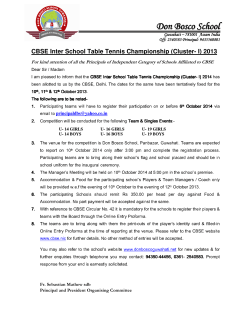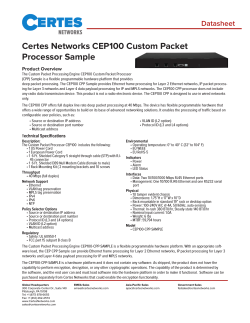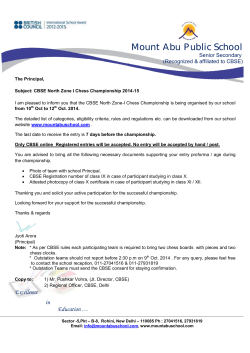
CBSE Sample Papers for Class 12 Chemistry Section-A (One Mark Questions)
CBSE Sample Papers for Class 12 Chemistry General Instructions: i) All questions are compulsory. ii) Marks for each question are indicated against it. iii) Question number 1 to 8 is very short answer questions, carrying 1 mark each. Answer these in one word or one sentence. CBSE Chemistry Sample Paper iv) Question numbers 9 to 18 are short-answer questions, carrying 2 marks each. Answer these in about 30 words each. v) Question numbers 19 to 27 are short-answer questions of 3 marks each. Answer these in about 40 words each. vi) Question numbers 28 to 30 are long-answer questions of 5 marks each. Answer these in about 70 words each. vii) Use Log Tables, if necessary Use of calculators is not permitted. Section-A (One Mark Questions) 1. Which Xe compound has distorted octahedral shape? 2. Give the IUPAC name of the following compound: (CH3)2C=CHCOOH 3. Write the reaction when glucose is heated with excess of HI. 4. What is the total number of atoms per unit cell in a face centered cubic (fcc) structure? 5. Why alkyl amine is more basic than ammonia? 6. Name one solid which has both schottky and frenkel defects. 7. Name a substance that can be used as an antiseptic as well as disinfectant. 8. On increasing temperature activation energy of a reaction decreases. Why? Section-B (Four Mark Questions) 9. Rate constant (K) for 1st order reaction has been found to be 2.54x10-3 sec-1. Calculate its three-forth life. 10. Do the following conversions: (i) Methyl bromide to acetone. (ii) Benzyl chloride to 2-phenyl acetic acid. 11.Give reasons for the followings: (i) Tertiary amines do not undergo acetylation reaction. (ii) O- Toludine is more basic than aniline. 12. Calculate the packing efficiency in ccp structure. 13.Complete the following chemical reaction equations: (i) P4 + NaOH+ H2O --------------> (ii) I- + H2O+ O3 ---------------------> 14.The resistance of a conductivity cell containing 0.001 M KCl solution at 298K is 1500 ohm. What is the cell constant if the conductivity of 0.001 M KCl solution at 298K is 0.146x10 -3S cm-1? 15.What happens when: (i) Cu2O undergoes self reduction in a silica line converter. (ii) Hematite oxidizes carbon to carbon monoxide. 16. Define the following by giving one example of each: (i) Antiseptics (ii) Antioxidants 17. a) Write the reaction of preparation of neoprene. b) Arrange the following polymers in decreasing order of intermolecular forces:PVC, Nylon 66, Natural rubber. 18. How does an emulsifying agent work? Give an example of emulsifying agent. Section-C ( Three Mark Questions) 19. Write balanced chemical equations for the following reactions: (i) Hypophosphorus acid is added to AgNO3 solution. (ii) XeF2 undergoes hydrolysis. (iii) Chlorine gas is passed through hot and concentrated solution of NaOH. 20. On dissolving 19.5g of CH2FCOOH in 500g of water, a depression of 10C in freezing point of water is observed. Calculate the Van’t Hoff factor and dissociation constant of fluroacetic acid. (Kf= 1.86K Kgmol-1) 21. Illustrate the following reactions by giving a chemical equation for each : (i) Kolbe’s reaction (ii) Cross aldol reaction. 22. Compare the following complexes with respect to their shape, magnetic behavior and the hybrid orbital involved : (i) [CoF4]2(ii) [Ni(CO)4] (iii) [Cr(H2O)2(C2O4)]23. Account for the followings: (i) In general the atomic radii of transition elements decrease with atomic number in a given series. (ii) The E0 value for Mn3+|Mn2+ couple is much more positive than for Cr3+|Cr2+. (iii) The transition metals form a large number of complex compounds. 24. How will you convert : (i) Ethyl benzene to benzoic acid. (ii) Acetaldehyde to but-2enal. (iii) Picric acid(2,4,6 tri nitro phenol) from phenol. 25. a) Calculate the emf of the cell: Mg(s)|Mg2+(0.1M) || Cu2+(1x10-3M)|Cu(s) Given E0 Cu2+|Cu= +0.34V, E0 Mg2+| Mg= -2.37 V b) What are weak and strong electrolytes? 26. a) Give one structural difference between amylase and amylopectin. b) Name two fat storing tissues in human body. c) What are fat soluble vitamins like A,D,E and K are store in human body. 27..Describe a chemical test in each case to distinguish between the following pairs of compounds: (i) Aniline and N-ethyl aniline (ii) N-methyl propane-2-amine and N-ethyl-N-methyl ethanamine Section-D (Five Mark Questions) 28. a) Give two consequences of lanthanide contraction. b) Complete the following reactions: (i) MnO4- +S2O32- +H2O-----> (ii) Cr2O72- +Sn2++H+----> c) Which of the following has maximum number of unpaired electrons:Ti 3+,V3+, Fe2+, Mg2+ d) Based on the data arrange Fe2+,Mn2+,Cr2+ in the increasing order of stability of +2 oxidation:state E0 Cr3+| Cr2+= -.4V, E0 Mn3+|Mn2+=1.5V, E0 Fe3+|Fe2+=0.8V 29. a) Define the terms Osmosis and Osmotic pressure. Is the Osmotic pressure of a solution of collective property? Explain. b) Calculate the boiling point of a solution prepared by adding 15g of NaCl to 250g of water Kb for water =0.512 K Kgmol-1, Molar mass of NaCl= 58.44gmol-1 30. How would you account for the following: (i) Most of the transition metals ions exhibit characteristics in colours in aqueous solutions. (ii) With the same d-orbital configuration(d4) Cr2+ is a reducing agent while Mn3+ is an oxidizing agent. (iii) All the P-Cl bonds in PCl5 molecule are not equivalent. (iv) Sulphur has greater tendency for catenation than oxygen. (v) SF6 is kinetically an inert substance towards hydrolysis.
© Copyright 2025





















